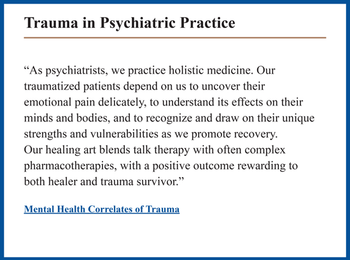
Trauma And Violence
Latest News
CME Content


Why do you need to know about Munchausen by Proxy? Answers here.

Substantial progress has been made in the development of etiologic models of intimate partner violence and interventions for individuals who assault their intimate partners. These authors provide details.

Detainees in state and federal prisons have committed crimes that many of us can never forgive. But how we treat such people beyond the loss of freedom and certain rights is entirely about who we are as a society. More in this commentary.

Those who have experienced extreme trauma and their descendents have taught us much about resilience, renewal, and redemption-outcomes that are all recalled in this period of the Jewish Passover, Christian Easter, and Holocaust Memorial Week.

Firearms are the means of death in thousands of suicides and homicides every year. There is no denying that free access and wide availability has made gun death a major threat to our public health. More in this commentary.

Mental health professionals can predict high-risk groups but can’t pick out who will go on a rampage. Murder is too much of a-needle in-the-haystack rare event to ever be reliably prevented with psychiatric tools. More in this commentary.

In periodic entries in his journal, the Columbia Mall shooter acknowledged having a “general hatred toward others.” He had insight into his deteriorating condition, as he felt himself slipping away from rationality and health.

There are many stories written about serial killers and murderers, books that narrate the life course of individuals who commit heinous acts. However, few have been written by murderers explaining their lives first-hand.

In the history of psychiatry, the First World War is often identified with the rise of the disorder of “shellshock.” However, many in both the medical community and the military establishment were dubious of the claim that war could produce psychiatric symptoms.

Snuggled into their seats like swaddled babes, moviegoers' safety seems implicit. It is utterly unimaginable that danger could ever be lurking in that enchanted darkness – except for the people on the screen.

It is important to note public misconceptions about the rare and frightening act of mass murder. This article sheds some light on what the author considers the 7 myths of mass murder.

A stalker may approach or follow the victim, or keep their residence under surveillance, setting up a perpetual cycle of fear for the victim and frustration or anger for the perpetrator. Here, subtypes of stalkers to determine which type of behavior his or her communications suggest.

We know so little about community grieving. What is normal and what is not? Perhaps the tragedy in Newtown needs a careful analysis over time.

I have often wondered: did any of Parkland's sets of medical eyes experience a moment of stillness with the collective father who had just been declared dead? I readily acknowledge the difficulty with great humility.

One is reminded of an ancient tale of 10 blind men sent by a king to describe an elephant. Whichever piece of the beast each blind man touched, so ran his faulty description. At one time or another the FBI, Army, and Hasan’s superiors each touched a piece of Nidal Hasan. Tragically, no one was able to assemble the entire frightful picture, and head him off at the pass.

Army psychiatrist MAJ Nidal Hasan sought to get out of the service, but the Army, which had poured hundreds of thousands of dollars into his military and medical training, offered him no legal exit.

Lack of communication is often a key factor in mass murder, according Phillip Resnick, MD. Although HIPAA is important, the safety of the individual and the public should outweigh privacy issues, and “risk to human life always trumps confidentiality.”

Here, suggestions for mental health professionals serving the needs of refugees from around the world who have been traumatized by violence.

As psychiatrists, we practice holistic medicine. Our traumatized patients depend on us to uncover their emotional pain delicately, to understand its effects on their minds and bodies, and to recognize and draw on their unique strengths and vulnerabilities as we promote recovery.

Former President of the American Psychiatric Association, Nada Stotland, MD, MS, speaks here about abortion-a subject that is especially important for psychiatrists in several ways.

When our jails become our largest public mental health facilities, we definitely have a problem-a problem we created-in how we respond to serious mental illness.

Combat veterans who have suffered a moral injury in the past may be predisposed to a recurrence of the painful memories associated with previous trauma after exposure to similar traumatic events with moral overtones.

Over half of the population is exposed to at least one lifetime traumatic event, yet relatively few of those exposed have lasting psychiatric sequelae. As psychiatrists, we attend to the needs of those who suffer.

Psychiatrists need to understand how living in violent families and neighborhoods increases the likelihood of trauma and the psychiatric sequelae associated with it as well as how to respond in the aftermath.







